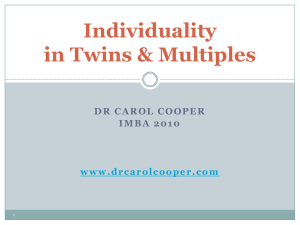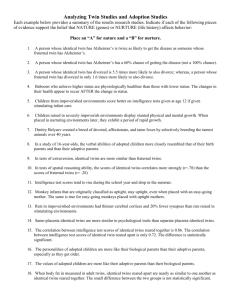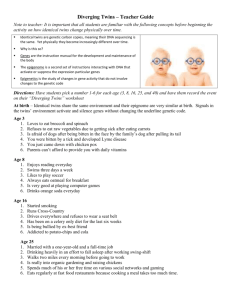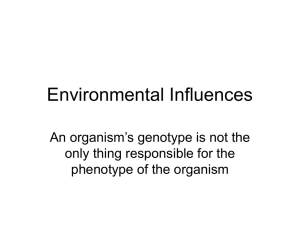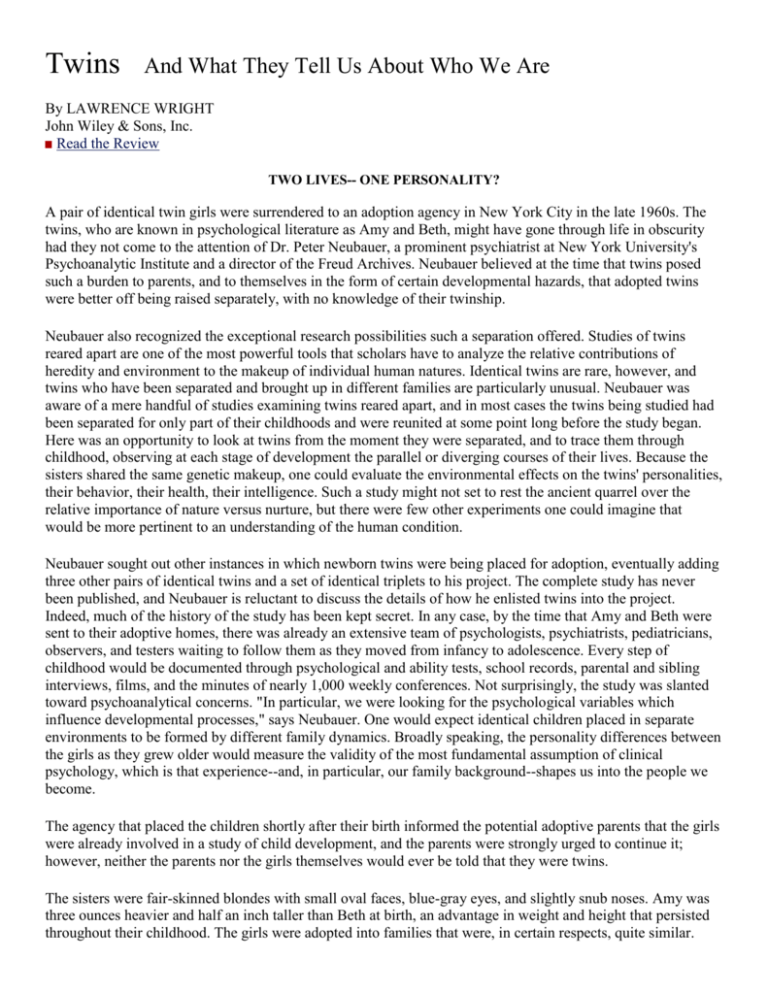
Twins
And What They Tell Us About Who We Are
By LAWRENCE WRIGHT
John Wiley & Sons, Inc.
Read the Review
TWO LIVES-- ONE PERSONALITY?
A pair of identical twin girls were surrendered to an adoption agency in New York City in the late 1960s. The
twins, who are known in psychological literature as Amy and Beth, might have gone through life in obscurity
had they not come to the attention of Dr. Peter Neubauer, a prominent psychiatrist at New York University's
Psychoanalytic Institute and a director of the Freud Archives. Neubauer believed at the time that twins posed
such a burden to parents, and to themselves in the form of certain developmental hazards, that adopted twins
were better off being raised separately, with no knowledge of their twinship.
Neubauer also recognized the exceptional research possibilities such a separation offered. Studies of twins
reared apart are one of the most powerful tools that scholars have to analyze the relative contributions of
heredity and environment to the makeup of individual human natures. Identical twins are rare, however, and
twins who have been separated and brought up in different families are particularly unusual. Neubauer was
aware of a mere handful of studies examining twins reared apart, and in most cases the twins being studied had
been separated for only part of their childhoods and were reunited at some point long before the study began.
Here was an opportunity to look at twins from the moment they were separated, and to trace them through
childhood, observing at each stage of development the parallel or diverging courses of their lives. Because the
sisters shared the same genetic makeup, one could evaluate the environmental effects on the twins' personalities,
their behavior, their health, their intelligence. Such a study might not set to rest the ancient quarrel over the
relative importance of nature versus nurture, but there were few other experiments one could imagine that
would be more pertinent to an understanding of the human condition.
Neubauer sought out other instances in which newborn twins were being placed for adoption, eventually adding
three other pairs of identical twins and a set of identical triplets to his project. The complete study has never
been published, and Neubauer is reluctant to discuss the details of how he enlisted twins into the project.
Indeed, much of the history of the study has been kept secret. In any case, by the time that Amy and Beth were
sent to their adoptive homes, there was already an extensive team of psychologists, psychiatrists, pediatricians,
observers, and testers waiting to follow them as they moved from infancy to adolescence. Every step of
childhood would be documented through psychological and ability tests, school records, parental and sibling
interviews, films, and the minutes of nearly 1,000 weekly conferences. Not surprisingly, the study was slanted
toward psychoanalytical concerns. "In particular, we were looking for the psychological variables which
influence developmental processes," says Neubauer. One would expect identical children placed in separate
environments to be formed by different family dynamics. Broadly speaking, the personality differences between
the girls as they grew older would measure the validity of the most fundamental assumption of clinical
psychology, which is that experience--and, in particular, our family background--shapes us into the people we
become.
The agency that placed the children shortly after their birth informed the potential adoptive parents that the girls
were already involved in a study of child development, and the parents were strongly urged to continue it;
however, neither the parents nor the girls themselves would ever be told that they were twins.
The sisters were fair-skinned blondes with small oval faces, blue-gray eyes, and slightly snub noses. Amy was
three ounces heavier and half an inch taller than Beth at birth, an advantage in weight and height that persisted
throughout their childhood. The girls were adopted into families that were, in certain respects, quite similar.
They were placed in Jewish homes in New York State. The mothers stayed at home, and in each family there
was a son almost exactly seven years older than the twin. (In Beth's family, there was an older sister as well.) In
other respects, the environments were profoundly different: notably, Amy's family was lower class and Beth's
was well off. Amy's mother was overweight and socially awkward. Her personality was flat and her self-esteem
was low. Although she had a compassionate side to her nature, she was an insecure mother who felt threatened
by her daughter's attractiveness. Beth's mother, on the other hand, doted on her daughter and for the entire ten
years of the study spoke positively of Beth's personality and her place in the family. The team described Beth's
mother as pleasant, youthful, slim, chic, poised, self-confident, dynamic, and cheerful. Whereas Amy's mother
seemed to regard Amy as a problem, a stubborn outsider, Beth's mother treated her daughter as "the fun child."
Instead of separating Beth from other members of the family, Beth's mother went out of her way to minimize
the differences, to the extent of dyeing her own hair to emphasize their similarities. The girls' fathers were very
much like each other--confident, relaxed, at ease with themselves--but different in their treatment of the girls.
Amy's father came to agree with his wife that Amy was a disappointment, whereas Beth's father was more
available and supportive. Amy's brother was a handsome academic star, the golden boy of the family. Beth's
brother, however, was a disturbed child who suffered from learning disabilities and uncontrolled behavior that
got him expelled from several schools and in trouble with the law. All in all, the research team characterized
Amy's family as a well-knit threesome--mother, father, and son--plus an alienated Amy. It was a family that
placed a high value on academic success, simplicity, tradition, and emotional restraint. Beth's family, on the
other hand, was sophisticated, full of energy--"frenetic" at times--and it tended to put more emphasis on
materialism than on education. Clearly, Beth was more at the center of her home than Amy was in hers.
And how did these identical twins in such contrasting environments turn out? As might be expected, Amy's
problems began early and progressed in a disturbing direction. As an infant, she was tense and demanding. She
sucked her thumb; she bit her nails; she clung to her blanket; she cried when left alone. She wet her bed until
she was four and continued to have "accidents" for several years more. She was prone to nightmares and full of
fears. By the age of ten, when the study concluded, she had developed a kind of artificial quality that manifested
itself in role-playing, gender confusion, and invented illnesses. Shy, indifferent, suffering from a serious
learning disorder, pathologically immature, she was a stereotypical picture of a rejected child. The team
proposed that if only Amy had had a mother who had been more empathetic, more tolerant of her limitations,
more open and forthcoming (like Beth's mother), then Amy's life might have turned out far better. If only her
father had been more consistently available and affectionate (like Beth's father), then she might have been better
able to negotiate the oedipal dramas of childhood and achieve a clearer picture of her own sexual role. If only
her brother had been less strongly favored (like Beth's brother), Amy would have been spared the mortifying
comparisons that were openly drawn in her family. In theory, if Amy had been raised in Beth's family, the
sources of her crippling immaturity would have been erased, and she would have been another kind of person-happier, one presumes, and more nearly whole.
In nearly every respect, however, Beth's personality followed in lockstep with Amy's dismal development.
Thumb-sucking, nail-biting, blanket-clenching, and bed-wetting characterized her infancy and early childhood.
She became a hypochondriac and, like Amy, was afraid of the dark and of being left alone. She, too, became
lost in role-playing, and the artificial nature of her personality was, if anything, more pronounced than that of
Amy's. She had similar problems in school and with her peers. On the surface, she had a far closer relationship
with her mother than Amy did with hers, but on psychological tests she gave vent to a longing for maternal
affection that was eerily the same as her identical sister's. Beth did seem to be more successful with her friends
and less confused than Amy, but she was also less connected to her feelings.
The differences between the girls seemed merely stylistic; despite the differences in their environments, their
pathology was fundamentally the same. Did their family lives mean so little? Were they destined to become the
people they turned out to be because of some inherent genetic predisposition toward sadness and unreality? And
what would psychologists have made of either girl if they had not known that she was a twin? Wouldn't they
have blamed the symptoms of her neurosis on the parenting styles of the family she grew up in? What does that
say about the presumptions of psychology?
Twins pose questions we might not think to ask if we lived in a world without them. They are both an unsettling
presence, because they undermine our sense of individual uniqueness, and a score-settling presence, because
their mere existence allows us to test certain ideas about how we are the way we are. Every culture has had to
confront the twin phenomenon and come to its own response. Often that response has been to kill the children
and to ostracize or kill the mother as well--an implicit acknowledgment of the threat twins can pose to the
presumptions of an established order. From ancient times men have been known to cut off one of their testicles
in the mistaken belief that it would eliminate the possibility of twin conceptions. Other cultures worship twins
as a divine gift; for instance, the voodoo practitioners of West Africa and Haiti exalt twins as supernatural
beings with a single soul, who are to be revered and feared. Once a year anyone connected to twins, living or
dead, is obligated to make offerings at a ceremonial feast in their honor to avoid "chastisement." In our own
culture, we tend to dote on twins and mythologize their specialness through daytime talk shows, which turn
them into freaks but which also, to be fair, provide a forum to marvel at the wonder and the mystery of the twin
event. Perhaps all these responses are ways of holding twins at bay, since too close a study of twinship might
lead to discoveries about ourselves that we are unwilling to make.
In the mid-sixties, when Neubauer began his enquiry into the lives of separated twins, there were no major U.S.
twin registries; now the University of Minnesota keeps track of more than 8,000 twin pairs; Virginia
Commonwealth University operates the "Virginia 30,000," which follows 15,000 twin pairs plus their siblings,
spouses, and parents; there are major registries in Kansas, California, and Kentucky, and smaller ones all over
the country. The Veterans Administration maintains records of all twins who served in the Second World War
and Vietnam. Pennsylvania State University, with several other institutions, oversees the Black Elderly Twin
Study, which uses Medicare records to track down black twins throughout the United States. It is the only largescale ethnic study in the country, but it may also become the largest study of genetics and aging among women
in the world. In Holland, Denmark, Sweden, Norway, Finland, and Australia nearly every twin in the country
has been identified. Moreover, in recent years, the technical analysis of twin studies has become increasingly
sophisticated and subtle, often taking into account multiple environmental factors, non-twin relatives, and longterm observations. As a result of the variety and complexity of twin studies, along with powerful tools for
analysis, the field of behavioral genetics has caused a revolution in the universities that has spilled into political
life, reshaping the way our society views human nature and changing the terms of the debate about what
government can and should do to improve the lives of its citizens.
Much of the argument over individual differences in intelligence, for instance, arises from the variation between
IQ test scores of identical and fraternal twins, the difference being a measure of how much of what we call
intelligence is inherited. The field of psychology has been shaken by separated-twin studies, such as the one of
Amy and Beth, suggesting that the development of an individual's personality is guided by his genes, with little
regard for the family in which he is raised. Matters that instinctively seem to be a reflection of one's personal
experience, such as political orientation or the degree of religious commitment, have been shown by various
twin studies to be partly under genetic control. Because of the growth of twin studies, and also adoption studies,
which examine unrelated individuals reared together (and which complement the study of twins reared apart),
the field of behavioral genetics has been able to study traits such as criminality, alcoholism, smoking,
homosexuality, marriage and divorce, job satisfaction, hobbies, fears; the results suggest that there are
significant genetic contributions in all cases. Even disciplines such as linguistics and economics have seized
upon twins as a way of understanding language formation (by looking at twins who create a private idiom), or
of calculating the additional earning potential of higher education (by comparing twins who go to college versus
twins who don't). There is an air of irrefutability about such studies that make them so appealing. When Linus
Pauling proposed that vitamin C could cure the common cold, for instance, twin pairs were separated into two
groups, one of which received vitamin C and the other a placebo. Both caught colds, which effectively
destroyed Pauling's theory. There are now so many scientists seeking to study twins that the annual festival of
twins in Twinsburg, Ohio, allows researchers to set up carnival tents, where browsing twins can stop to take
stress tests or fill out questionnaires about their sex lives. Festival organizers even sponsor a prize for the best
research project. Last year 90,000 people--most of them twins--attended the event.
All this comes after several decades of heightened political struggle between those, on the one hand, who
believe that people are largely the same and that differences are imposed upon them by their environment, and
those, on the other hand, who conclude that people differ mainly because of their genes, and that the
environments they find themselves in are largely of their own making or choosing. Obviously, the roots of
liberal versus conservative views are buried in such presumptions about human nature.
This argument has been raging for centuries, with science entering evidence on either side and public opinion
shifting in response. Using twins, and also data derived from adoption studies, scientists can now estimate what
proportion of the variation in our intelligence, our personality, our behavior, and even seemingly random life
events such as bankruptcy or the death of a spouse, might be caused by inherited tendencies. The broad
movement from environmentalism to genetic determinism that has occurred in psychology over the last thirty
years has foreshadowed the increasingly popular belief that people are genetically programmed to become the
way they are, and therefore little can be done, in the way of changing the environment, that will make an
appreciable difference in improving test scores or lowering crime rates or reducing poverty, to name several
conspicuous examples.
The hallmark of liberalism is that changes in the social environment produce corresponding changes in human
development. But if people's destinies are written in their genes, why waste money on social programs? Such
thinking has led to a profound conservative shift in the last thirty years. This can be demonstrated by comparing
the shifting climate of opinion in the United States, which in 1965 produced the Great Society--a vast number of
social programs designed to improve the health and welfare of the poor, the elderly, and the minority
populations--and in 1995 brought about the Contract with America, which generated cutbacks in many of those
same programs and marked a change in attitude about what government can be expected to do for its citizens.
These changes have taken place not only in the West but in many other countries as well. Indeed, the
widespread retreat of communism as a force in world politics is doubtlessly linked to the collapse of faith in
social engineering, caused by the failure of communism to create the positive changes expected of it.
The genetic idea has had a tumultuous passage through the twentieth century, but the prevailing view of human
nature at the end of the century resembles in many ways the view we had at the beginning. That is that people
are largely responsible for their station in life, and that circumstances do not so much dictate the outcome of a
person's life as they reflect the inner nature of the person living it. Twins have been used to prove a point, and
the point is that we don't become. We are.
(C) 1997 Lawrence Wright All Rights Reserved ISBN: 0-471-25220-4



